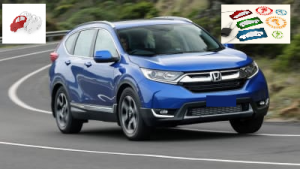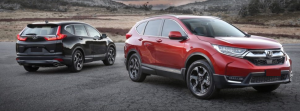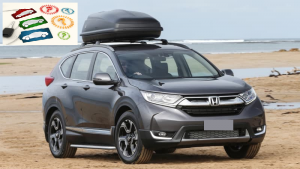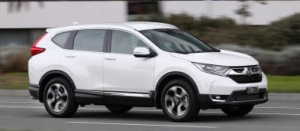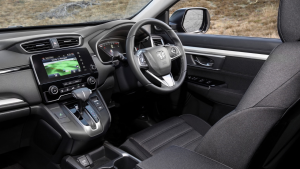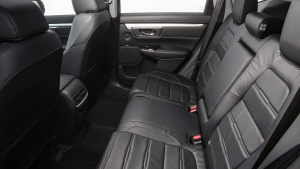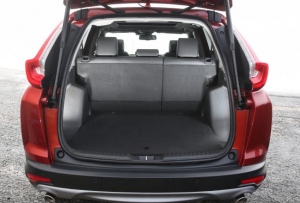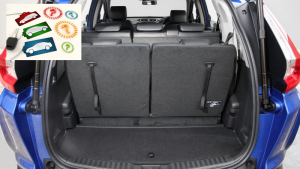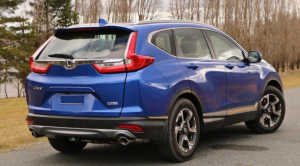DABAS Blog post; 12th of June 2018
Hello readers, at DABAS we hope you had a great Melbourne long weekend/public holiday. In last week’s DABAS Blog we had a look at the Honda HR-V; which is on run-out sale presently, as promised to a loyal Honda owner looking to update: this week we will look at the HR-V’s larger sibling, the 2018 Honda CR-V range. We hope you find it an interesting read, providing some useful information to help you on your car-buying journey.
If you would like DABAS to assist you in your journey to purchase one of the new 2018 Honda CR-V variants please click here.
Here we go:
The current model 2018 Honda CR-V‘s evolution was launched in mid-2017 to new-car buyers in Australia, giving the company an opportunity to tackle this segment’s rivals such as the Mazda CX-5, Hyundai Tucson and Toyota RAV4.
The 2017/2018 CR-V is a redesigned and generally more sophisticated CR-V model than its predecessor and was the latest part of Honda’s product-led revival, joining the Civic sedan and hatch, and its smaller Honda stable sibling the Honda HR-V.
This latest Honda CR-V is the fifth iteration of the Honda CR-V since the nameplate’s 1995 debut. It is estimated more than nine million have been sold worldwide, including 170,000 locally in Australia. The CR-V was said to be a pioneer in the medium-compact SUV class that is now one of the fastest-growing segments of the Australian automotive market.
The new range comes in four levels of specification, and is available with front- or all-wheel drive and a solitary turbo-petrol engine offering. It’s bigger and more spacious than its predecessor, and also comes for the first time with seven seats available.
While its segment opposition the Mazda CX-5 or Volkswagen Tiguan is pitched as something of a fashion or lifestyle statement, the CR-V is aimed squarely at families, people who probably value practicality and ride height above all else.
The 2018 Honda CR-V ticks almost all of the requisite boxes for SUV buyers and leaps immediately onto our segment shortlist if you were looking in this segment.
Design- Some say looks are subjective, but the new CR-V is this segment’s best-looking Honda in some time. The current model CR-V is clean, contemporary and good- looking design.
Compared to its predecessor the new CR-V’s wheelbase is longer, reducing overhangs. The rear wheel arches are flared, the windows are raked (and still big), the bonnet is stylised and the vertical tail-lights are funky. It has presence, a good stance plus great proportions.
All the latest CR-V models have LED daytime running lights, too, though only the VTi-LX gets LED headlights.
Under the bonnet is a similar 1.5-litre petrol engine to the Civic, fitted with a larger turbocharger – and different turbine blades designed to reduce resultant spool-driven lag. Outputs are good for the class, despite the small capacity, reported as 140kW at 5600rpm and 240Nm between 2000 and 5000rpm.
Many rivals in comparison use a (some say) anaemic engine at base level, but the CR-V offers this motor across CR-V variants; no diesel option is available with the current Honda CR-V.
Estimated fuel consumption is 7.0-7.4L/100km, though some say with real-life driving it’s around 9.0L/100km. And for the rev-heads reading this Blog: the 0-100km/h time is 9.9 seconds.
The engine is matched as standard to a CVT-style automatic gearbox (with paddles on the two highest grades) designed to reduce cost, weight and emissions. In base models it channels engine torque to the front wheels, but higher grades come with an on-demand all-wheel-drive (AWD) system.
It’s said to be an acceptable engine, good for an entry model and acceptable for the more expensive grades, getting the circa 1600kg (varies by variant) Honda CR-V rolling along well under load and offering good responsiveness for family commuting.
The CR-V’s AWD system is quite clever. Uncommonly, the car can take off from the line in all-paw mode to maximise initial traction and then it’s only at speed in nice conditions where the car reverts to FWD. The sensors on board re-send torque rearward (up to 40 per cent total) when slip up front is detected. It’s also worth noting that the CR-V’s ground clearance is up substantially to 208mm, which is higher than most key rivals bar the (210mm) Nissan X-Trail.
The chassis of the new CR-V is a new design: increased front and rear track widths, combined with rejigged front MacPherson strut and rear multi-link suspension (with low-friction dampers and tubular front/solid rear stabiliser bars) help sharpen up turn-in and flatten the body against lateral cornering inputs. There’s also a new electric power steering system, new fluid-filled suspension bushes and more noise-deadening insulation, and better sealing of gaps. Also standard is an electric parking brake with automatic brake hold to stop you when creeping around town, and an Active Noise Control system that keeps out road and wind noise. The suppression of noise, vibration and harshness (NVH) is good for the segment, while the steering is said to have a quick responsive action.
It is reported that the CR-V is not a corner-carver like a Tiguan or CX-5, but its ride quality is said to be great, and the body control/handling safe and predictable.
The CR-V’s cabin layout is admirable; it blends tasteful material quality on all variants with typical Honda virtues of space, practicality, tough build quality, and attention to detail. Recognisable Honda styling, including a floating tablet screen, space-age digital instruments that do the job, good material textures, thin A-pillars, brilliant cabin storage solutions with a glovebox that can fit a large handbag.
CR-V variants
VTi – starting things off at $30,690 (before on-road costs) is the CR-V VTi with five seats and FWD, matching the entry Nissan X-Trail ST CVT auto.
Standard fare includes 17-inch alloy wheels with a full-size alloy spare, roof rails, LED daytime running lights (DRLs), keyless entry with push-button start (another great addition), reversing camera, dual-zone climate control and cloth seats. Infotainment comes via a 7.0-inch colour touchscreen paired to eight speakers. There’s no integrated sat-nav but you get Bluetooth/USB, plus Apple CarPlay and Android Auto phone mirroring software. Safety equipment is limited to six airbags and a Driver Attention Monitor that makes sure you’re alert, plus all the usual safety ‘acronyms’ (ESC, ABS etc.).The VTi variant does not come standard with AEB, (in an age when Autonomous Emergency Braking is become commonplace on other base models)
VTi-S: The next variant step up is the VTi-S five-seater – which Honda expects will be the top-seller, priced at $33,290 in FWD form or $35,490 with AWD. It’s said to be the pick of the range for family value. Additional features for the $2600 premium include 18-inch alloy wheels, an electric tailgate with height adjustment; good satellite-navigation with SUNA updates, front and rear parking sensors, Honda’s LaneWatch blind-spot camera, automatic dusk-sensing headlights, electrically retractable door mirrors and a leather-wrapped steering wheel.
VTi-L: The next variant up is the sole seven-seat option named the CR-V VTi-L, – priced at $38,990 with front-wheel drive only, and therefore rivalling the X-Trail ST-L and Mitsubishi Outlander LS, or even something like the Skoda Kodiaq or a base Hyundai Santa Fe Active X.
Additional features include seven seats with airbag protection for the rearmost row, plus luxuries such as a panoramic sunroof, leather-appointed seat trim, heated front seats, eight-way adjustable electric driver seat with lumbar support and memory, automatic rain-sensing wipers and third-row ceiling vents.
VTi-LX : Topping the variant range is the CR-V VTi-LX five-seater with AWD priced at $44,290.
Additional features include privacy glass, full LED headlights with active cornering lights, a High-beam Support System (HSS), auto-dimming interior rear-view mirror, digital radio (DAB+) and a leather-wrapped gear knob. You also get Honda’s entire active and preventative safety tech including Adaptive Cruise Control, Forward Collision Warning, Autonomous Emergency Braking (AEB), Lane Departure Warning, Road Departure Mitigation System and Lane Keep Assist. It seems a shame that Honda doesn’t offer this set of safety tech as an optional pack on lower grades, or make AEB standard on all variants of the CR-V.
To the back seats: every single CR-V variant offers two rear USB points and air vents, plus very large door pockets and a flip-down centre armrest. And both the VTi/VTi-S’ cloth trim and the VTi-L and VTi-LX’s leather trim are reported to be above-average in grade.
The five-seat CR-Vs offer perhaps the best back seats in the class, in terms of headroom, legroom, foot space, storage, amenities, simplicity of ISOFIX/tether access, entry/exit through the doors and outward visibility. The seats also recline. Only the X-Trail, Renault Koleos and Tiguan can compete.
The seven-seat VTi-L option: the middle seats slide on rails and the tilt/tumble mechanism to access the third row works well, as do the roof-mounted vents. But it is said these latter features also decimate headroom, alongside the sunroof, meaning anyone over 180cm will feel squeezed in the middle seat row, even in the outboard seats. And the third-row pews are obviously for small children only.
Cargo space remains above the class average at 522L behind the second-row. The middle seats also fold flat, and can be made to do so via levers in the cargo area, liberating a 1.85m long flat space. The programmable electric tailgate makes loading pretty simple.
The cargo area is well-lit, offering various handy hooks for shopping bags, a 12V socket, and has aforementioned full-size alloy spare wheel/tyre as standard, with a sturdy jack. There’s also a sliding cargo cover.
The CR-V gets Honda’s new five-year/unlimited kilometre warranty as standard (at times 7-years warranty is offered on CR-Vs), and capped-price servicing at 12-month/10,000km intervals. You’ll pay a below-average $1475 over the first 50,000km or five years at current prices, whichever comes first.
While the lack of room in the seven-seater is reported to be a potential problem for tall/big people, and the current lack of active safety inclusions below the range-topper is a clear oversight, the Honda reportedly sits at or near the top of its segments class for five-seat cabin layout, storage, equipment and overall ease-of-use.
It is said that with the Honda CR-V’s sharp design, respectable powertrain, good comfortable cabin layout plus ride characteristics with reportedly solid and predictable handling, and the excellent pricing structure (and at times a 7-year warranty), you have an obvious choice to consider shortlisting, (just perhaps not in seven-seat form if you are tall and wanting to sit in the very back seats).
If you would like DABAS’s help buying yourself a brand-new Honda CR-V please click here
To see the drive-away deals Honda Australia is currently offering on the Honda CR-V please go to the Honda Australian website.
At DABAS we know that buying a car to suit your needs can be one of the biggest purchases in your life; we hope this intended to be general -in-nature advice and Blog page has provided some helpful information to assist you in deciding the path of your car-buying journey.
We look forward to having a chat when the need arises for you to update your car; to assess your personal car-safety requirements and buying needs to suit your lifestyle,
And importantly your set specified budget!
Whatever roads your life journey takes you on DABAS can help you find a car to travel those roads.
To contact DABAS to discuss your car-buying needs . . . please click here
Please note: All pricing mentioned in this Blog page would be considered expired or sold out within 12 hours of this Blog-post’s publication date: all specifications etc. – mentioned in this blog page will be confirmed together with a Honda sales representative in their showroom upon your transition to becoming a client of DABAS.
Thanks for visiting DABAS’s website and blog: Have a great day
Cheers, Tim.

